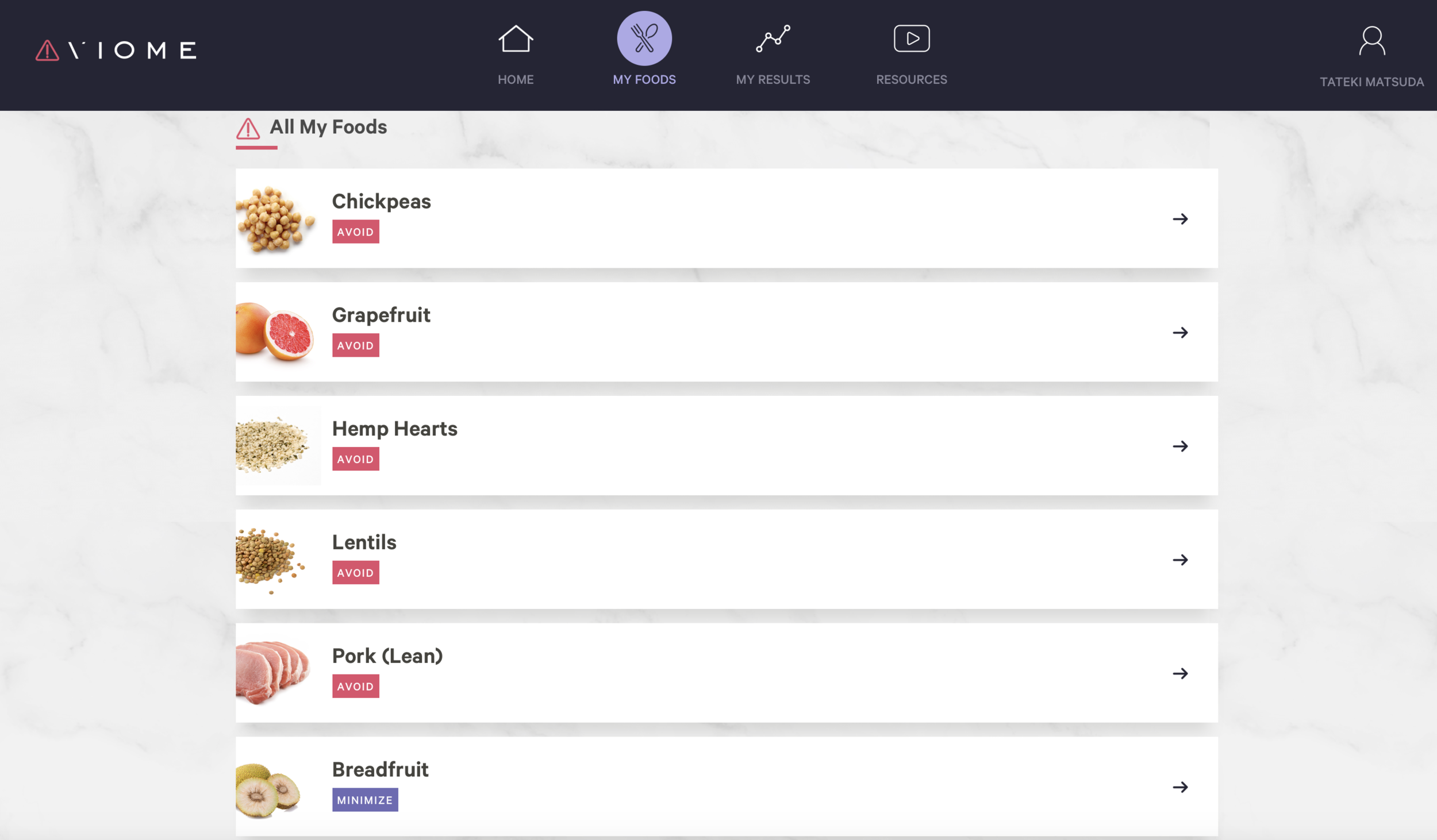Viome
Viome test kit
What Is Viome?
The word microbiota represents an ensemble of microorganisms that resides in a previously established environment. Human beings have clusters of bacteria in different parts of the body, such as in the surface or deep layers of skin (skin microbiota), the mouth (oral microbiota), the vagina (vaginal microbiota), and so on.
Viome applies artificial intelligence and machine learning to recommend personalized nutritional recommendations that balance the gut microbiome inside the body for the goal of better digestive health, longevity, skin quality, brain function, and any other physiological parameter correlated to the host of critters living in your gut.
Do any of the following issues hold for you or a loved one? Have you considered these solutions?
Issue#1: Despite my dieting, I can’t maintain my weight.
Solution#1: No one diet is right for everyone.
Issue#2: I can’t focus during the day.
Solution#2: Your brain uses more energy than any other tissue in your body. For your brain to work, you need to eat a combination of foods that will optimize your body’s energy production and enhance your focus.
Issue#3: I feel bloated after almost every meal.
Solution#3: If you aren’t eating the right foods for your microbiome, you can feel the consequences. Viome identifies the ideal diet to help your gut thrive.
Issue#4: I don’t have the energy to do the things I love.
Solution#4: The food you eat gets processed into energy. When you eat the foods that are right for your microbiome and biochemistry, this process becomes efficient—resulting in maximal energy.
Issue#5: I have trouble falling asleep and staying asleep.
Solution#5: Your microbiome affects your biological clock. An analysis of your microbiome will provide the needed information to help you maintain it at its most healthy functioning level, which may improve your sleep.
For many people, the issues are widespread and may feel inescapable. While so many of us and our loved ones, colleagues, and acquaintances struggle with these issues, for most, the given solutions are unfamiliar. The solutions use words such as “microbiome” and suggest connections that we haven’t encountered before. From reading these solutions, you might be left wondering:
• What’s a “microbiome”?
• What’s the relationship between my “microbiome” and my health?
• How can I harness my “microbiome” to optimize my health and well-being?
Viome Complete Microbiome and Metabolic Testing and optimization
Gut microbiota (formerly called gut flora)
Our gut microbiota contains tens of trillions of microorganisms, including at least 1000 different species of known bacteria with more than 3 million genes (150 times more than human genes). Microbiota can, in total, weigh up to 2 kg. One-third of our gut microbiota is familiar to most people, while two-thirds are specific to each one of us. In other words, the microbiota in your intestine is like an individual identity card.
In our Gut
As its name states, the gut microbiota is harbored in the intestine, one of the main areas in our bodies that come into contact with the external environment (other examples are the skin and the lungs).
Why is it important?
While each of us has a unique microbiota, it always fulfills the same physiological functions, with a direct impact on our health. Some of the functions are:
It helps the body to digest certain foods that the stomach and small intestine have not been able to digest.
It helps with the production of some vitamins (B and K).
It helps us combat aggressions from other microorganisms, maintaining the wholeness of the intestinal mucosa.
It plays an important role in the immune system, performing a barrier effect.
Healthy and balanced gut microbiota is key to ensuring proper digestive functioning.
Taking into account the major role gut microbiota plays in the normal functioning of the body and the different functions it accomplishes, experts nowadays consider it as an “organ." However, it is an “acquired" organ, as babies are born sterile; that is, intestine colonization starts right after birth and evolves as we grow.
The development of gut microbiota starts at birth
The newborn’s digestive tract is quickly colonized by microorganisms from the mother (vaginal, fecal, skin, breast, etc.), the environment in which the delivery takes place, the air, etc. From the third day, the composition of the intestinal flora is directly dependent on how the infant is fed: breastfed babies’ gut microbiota, for example, is mainly dominated by Bifidobacteria, compared to babies nourished with infant formulas. Scientists consider that by the age of 3, microbiota becomes stable and similar to that of adults, continuing its evolution at a steadier rate throughout life.
“Each person’s microbiome is unique although all humans have some species of bacteria and other microorganisms in common at each site.”
A Codependent Relationship
The more scientists learn about these microorganisms and what they are doing, the more we realize they are not just an accessory; they are a vital part of what it means to be a fully-functioning human. We are not discrete packages of human genes. We are bundles of both human and bacterial genes, continually interacting and evolving. We are super-organisms. Microorganisms have been around for much, much longer than humans on the evolutionary timeline, making us humans mere tourists in a vast, ancient microbial world. Rob Knight, a microbial ecologist and researcher at UC San Diego, wrote in his book Follow Your Gut, “The emerging facts about this tiny world serve as a rebuke to our egos.” We are in a codependent relationship with the microorganisms of our microbiomes. There’s an elegant symbiosis happening.
Gut Microbiota As The Body’s Engine
Of all the places on the body, the highest numbers of bacteria and other microorganisms are found in the digestive tract, also known as the “gut.” The colon has the most enormous numbers of microbes, with hundreds of different species working together and competing with each other for food and real estate. Microbes live in communities all along the digestive tract, starting at the mouth and continuing through to the bottom end of your colon. Differences in pH and oxygen mean conditions vary in different parts of the gut, and these affect the microbes that live there. So, for example, some of the microbes that live in the mouth, where there’s constant exposure to oxygen, can’t survive in the folds of the small intestine where little or no oxygen is available. Scientists know the gut microbiota of a child changes its composition from infancy through toddlerhood and beyond. By the time a child turns three, their microbiota already seems to approximate the microbiota of an adult. So even though a child of three years may not be able to understand the punchline of a joke or swing from the monkey bars, they might have a gut microbiome that has achieved a level of stability beyond their years. Data indicate that the gut microbiome continues to shift throughout life, but not on the same scale as in early childhood. Enormous variation exists in the kinds of microorganisms in the gut—even different bacterial species from the same genus can differ in significant ways.
Transforming What You Eat
Whatever you consume—be it an apple or a bag of flavored tortilla chips—enters your body and is shunted down the tubes of the digestive tract. As the food travels through your gut, digestive processes successively break it down into parts that your body can more easily absorb. But you’re not just eating for yourself—you’re eating for your trillions of microorganisms, too. The activities of microbes in the gut play starring roles in the process of digestion. They make vitamins, such as B12 and K, that your body can’t make on its own. And while many components of food are absorbed higher up in the digestive tract (that is, in the small intestine), particular kinds of fiber called non-digestible carbohydrates make it down to the colon intact. These non-digestible carbohydrates are unique. They’re called non-digestible because—you guessed it—your body can’t break them down. So what’s a body to do? Here’s where gut microorganisms come in. When non-digestible carbohydrates reach the vast community of microorganisms in the colon, these microbes work to break them down. (In fact, some have started to call these carbs “microbiota-accessible carbohydrates or MACs.) As bacteria break down this kind of fiber, they produce many different products. The molecules produced in this manner are called “metabolites”—and as the ultimate recycling plant, the body takes some of these bacterial end products and puts them to use.
What is Inflammation?
You want your immune system to be constantly active to keep harmful substances at bay—but how active? To remain healthy, the immune cell activity must be just the right level: too high means the body starts attacking its healthy tissues, and too low means the immune system might fail to eliminate harmful invaders. In either of these cases, tissue injury can occur, resulting in inflammation. Excess inflammation in particular areas or throughout the body can lead to a long list of chronic diseases, from cardiovascular disease (systemic or whole-body inflammation) to ulcerative colitis (inflammation at a particular body site—in this case, the large intestine).
Viome Complete Microbiome and Metabolic Testing and optimization
Healthy and Pain-Free Feet
Most footwear today attacks from all angles. From narrow toe boxes to raised heels, to cushioned soles and stiff arches—our feet are subject to all sorts of confinement and artificial support. Most shoes go way beyond the innocent intention of protecting from hazards underfoot.
Several studies have investigated the kinematic and kinetic differences between rearfoot strike (RFS), midfoot strike (MFS), and forefoot strike (FFS) patterns at foot landing and their effects on running efficiency on a treadmill and overground conditions. There is an interesting study to document actual foot strike patterns during a half marathon in which elite international level runners, including Olympians, compete.
While good minimalist footwear mimics being barefoot, if you are used to wearing standard modern shoes, the way you use your feet has most likely been altered. Stiff shoes with cushioned soles limits range of motion and lead to heel-striking.
This is a part of my result screen.
How Viome Works
Viome was born at the prestigious Los Alamos National Lab and originated from technology initially designed for national security. It is based on the complete sequencing of the gut microbiome based on a tiny stool sample.
Viome Gut Microbiome Gene Expression
After identifying your gut’s composition, Viome goes on to understand how your microorganisms function. Measuring the functions of the microbes—what their genes tell them to do—is hugely important, as scientists have begun to suggest that the function of the microbiome is more important than the composition to health and disease outcomes. To understand this better, let’s say your gut microbes were at a job interview. Would you want to hire them based on their resume alone, or would you prefer to see what they could do on the job? The latter gives you much more certainty about their performance.
Similarly, the practical information you get from a gut microbiome test can go a step beyond details about what the microbes can do in a hypothetical sense: it can tell you what genes they are expressing. This kind of analysis, called metatranscriptomics, gives you a much more realistic picture of what is happening in your gut and how the microbes are affecting you. This kind of test also shows whether human RNA is present, and if so, it may indicate a breakdown of your gut lining.
Customized and Continuing Recommendations
Using these analyses, Viome recommends to you your optimal diet along with other customized diet recommendations that do the following:
• Focus on plant-based nutrition with individualized serving suggestions of animal and plant proteins and fats
• Identify foods that are most compatible with your microbiome
• Recommend a diet that will increase your energy, focus, and well being
• Recommend a diet to help you achieve and maintain a healthy weight
• Optimize your digestion and absorption
• Introduce beneficial bacteria with probiotics
The result? You can fine-tune the function of your gut microbiome to minimize the production of harmful metabolites and maximize the production of beneficial ones so that you experience increased energy and general well-being, all while reaching and maintaining a healthy weight. Chronic inflammation is also addressed, and beneficial bacteria are restored. And by truly—and scientifically—understanding the inner workings of your gut microbiome, Viome’s proprietary technology helps maintain overall wellness.
Viome Complete Microbiome and Metabolic Testing and optimization
Optimized life is to share my experience as a pro MMA fighter and health practitioner. These contents of this page show you how to get your body performing at peak capacity, with maximum fat burning efficiency and ideal hormonal and health status.
This page will also provide guidance on how athletes can collaborate with coaches to develop the proper combination of strength and conditioning and performance training for each athlete. This not only prepares athletes better, but helps prevent over reaching and over training.
You’ll learn about fat burning efficiency zones, gut health, mental performance, maximizing recovery, and enhancing every possible aspect of you body.
-
2025
- Dec 10, 2025 Japanese Chrono Trigger: Rethinking Time and Longevity
- Jun 5, 2025 Biohacking Conference 2025
-
2024
- Jul 20, 2024 Meltingpot Forum 2024
- Jul 3, 2024 Biohacker Summit Helsinki 2024
- Apr 10, 2024 Biohacker’s Retreat in IBIZA 2024
-
2023
- Oct 29, 2023 Biohacker Summit Amsterdam 2023 Show Notes
- Sep 18, 2023 Biohacker’s Retreat September 2023
- Sep 4, 2023 Biohacker Summit London 2023 Show notes
- May 1, 2023 Biohacker’s Retreat April 2023
- Apr 13, 2023 Cheese and Your Health: The Impact of Fermentation, Type, and Production Method
- Mar 12, 2023 Fermentation Makes Processed Meat Different
- Jan 29, 2023 Eat “Cultural Heritage.” Osechi Japanese New Year’s Food
-
2022
- Dec 23, 2022 “Mirin” Sweet Rice Sake Beyond Seasoning
- Nov 7, 2022 Japanese Drinkable IV “Amazake”
- Oct 16, 2022 Biohacker Summit Amsterdam 2022
- Oct 2, 2022 Fermented Foods for Healthy Skin
- Aug 10, 2022 Fermented Foods for Immune System
- Jun 26, 2022 Fermented Foods for Health Optimization
- Jun 4, 2022 Biohacker Summit Helsinki 2022
-
2019
- Nov 9, 2019 Spartan race Boston at Fenway Park 2019
- Nov 2, 2019 Biohacker Summit Helsinki 2019
- Aug 14, 2019 Boston Super and Sprint Weekend 2019
- Jul 2, 2019 Viome
- Jun 7, 2019 Earth Runner
- May 15, 2019 BIO CBD plus
- Mar 17, 2019 Keto Mojo
-
2018
- Dec 10, 2018 Complete Nutrition with Bits
- Aug 12, 2018 First time Spartan Race
- Aug 1, 2018 keto box
- Jun 4, 2018 Mushroom Coffee
-
2017
- Dec 30, 2017 After Week 12
- Nov 26, 2017 Week 10 & 11
- Nov 13, 2017 Week 8 & 9
- Oct 30, 2017 Week 6 & 7
- Oct 13, 2017 Week 5
- Oct 6, 2017 Week 4
- Sep 29, 2017 Week 3
- Sep 11, 2017 Determination
-
2016
- Sep 11, 2016 REhydration Process
- Aug 13, 2016 SFG Level 1 Test
- Feb 21, 2016 Conditioning during Fight Week
-
2015
- May 29, 2015 Dropping a Weight Class
- Apr 10, 2015 Random Day of my Training
- Feb 10, 2015 No Season for MMA Fighters
-
2014
- Aug 27, 2014 Hit some Swings
- Jun 24, 2014 MMA Fight Prep 5
- Jun 23, 2014 MMA Fight Prep 4
- Jun 23, 2014 MMA Fight Prep 3
- Jun 21, 2014 MMA Fight Prep 2
- Jun 20, 2014 MMA Fight Prep 1
















